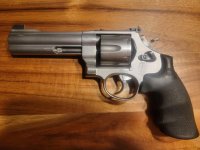I recently purchased online a Smith & Wesson Model 625-4 (Model 1989) in .45 ACP. I have been shooting S&W and Colt double-action revolvers since 1969 and currently own 23 of them, one of which is a 4-inch Model 25-5 .45 Colt. I have never encountered a double action like this one.
SERIAL NUMBER CAY 532X
I am unsure of the exact terms, but it appears to be a two-stage double action. When I pull the trigger, which is very light, the cylinder revolves to the next position, and the hammer goes to basically half cock position, and then the trigger meets a wall. It is not a true half cock in that it isn't held in a position such as on a Colt SAA.
When the trigger is released, the hammer drops back down, but when this happens, the firing pin does not protrude through the back plate. The timing and cylinder alignment are perfect. When you pull the trigger but don't go by the wall to fire the weapon, the cylinder rotates. I don't have a trigger gauge, but I would estimate the double action pull after the wall is met is around 6 lbs, very light and smooth. You can cock the hammer and fire it single action, but the SA pull is far too light.
When you go past the wall, the trigger is crisp, breaks cleanly, very fast with no creep or backlash, and fires. It is very accurate with my Auto Rim reloads,
What is great is that firing the revolver double is very much like firing one single action. There is no wavering on the target, accomplished without learning to stack the trigger pull in double action. I'm guessing it has some custom trigger conversion, perhaps for competition,as the 5" barrel ported. I have never encountered or even heard about such a setup. I did Google searches and came up blank.
Any thoughts or information would be appreciated. Also, it has a cylinder release that is different from other S&Ws. I paid $950 for it. The seller got it in a trade and didn't know its history.
SERIAL NUMBER CAY 532X
I am unsure of the exact terms, but it appears to be a two-stage double action. When I pull the trigger, which is very light, the cylinder revolves to the next position, and the hammer goes to basically half cock position, and then the trigger meets a wall. It is not a true half cock in that it isn't held in a position such as on a Colt SAA.
When the trigger is released, the hammer drops back down, but when this happens, the firing pin does not protrude through the back plate. The timing and cylinder alignment are perfect. When you pull the trigger but don't go by the wall to fire the weapon, the cylinder rotates. I don't have a trigger gauge, but I would estimate the double action pull after the wall is met is around 6 lbs, very light and smooth. You can cock the hammer and fire it single action, but the SA pull is far too light.
When you go past the wall, the trigger is crisp, breaks cleanly, very fast with no creep or backlash, and fires. It is very accurate with my Auto Rim reloads,
What is great is that firing the revolver double is very much like firing one single action. There is no wavering on the target, accomplished without learning to stack the trigger pull in double action. I'm guessing it has some custom trigger conversion, perhaps for competition,as the 5" barrel ported. I have never encountered or even heard about such a setup. I did Google searches and came up blank.
Any thoughts or information would be appreciated. Also, it has a cylinder release that is different from other S&Ws. I paid $950 for it. The seller got it in a trade and didn't know its history.
Attachments
Last edited:


